Page 292 of 442
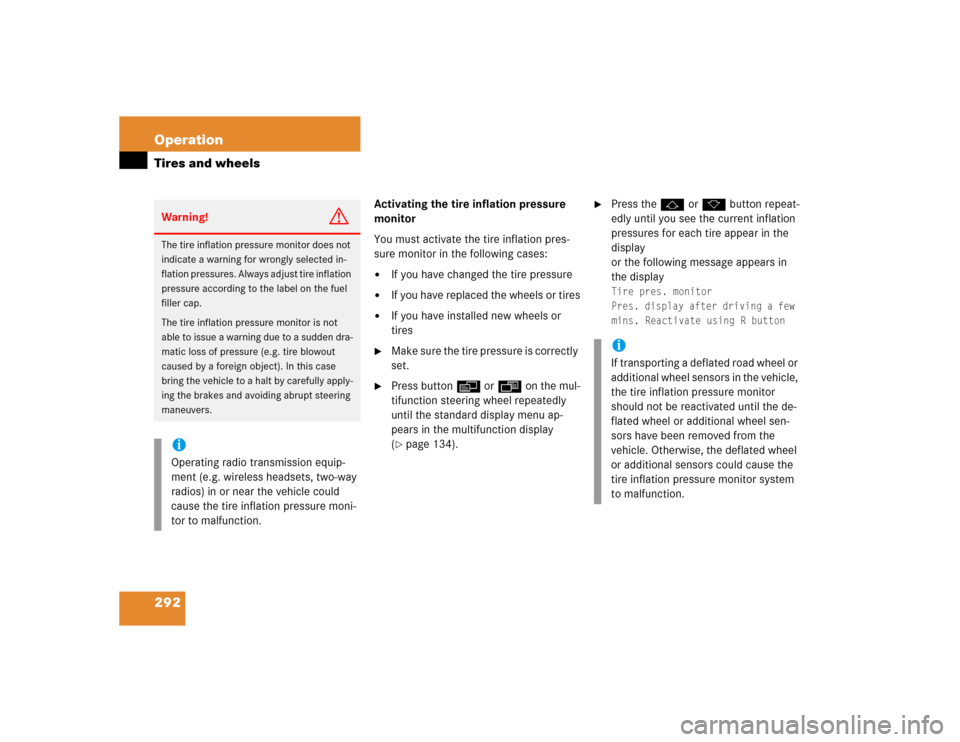
292 OperationTires and wheels
Activating the tire inflation pressure
monitor
You must activate the tire inflation pres-
sure monitor in the following cases:�
If you have changed the tire pressure
�
If you have replaced the wheels or tires
�
If you have installed new wheels or
tires
�
Make sure the tire pressure is correctly
set.
�
Press buttonè orÿ on the mul-
tifunction steering wheel repeatedly
until the standard display menu ap-
pears in the multifunction display
(�page 134).
�
Press the j or k button repeat-
edly until you see the current inflation
pressures for each tire appear in the
display
or the following message appears in
the displayTire pres. monitor
Pres. display after driving a few
mins. Reactivate using R button
Warning!
G
The tire inflation pressure monitor does not
indicate a warning for wrongly selected in-
flation pressures. Always adjust tire inflation
pressure according to the label on the fuel
filler cap.
The tire inflation pressure monitor is not
able to issue a warning due to a sudden dra-
matic loss of pressure (e.g. tire blowout
caused by a foreign object). In this case
bring the vehicle to a halt by carefully apply-
ing the brakes and avoiding abrupt steering
maneuvers.iOperating radio transmission equip-
ment (e.g. wireless headsets, two-way
radios) in or near the vehicle could
cause the tire inflation pressure moni-
tor to malfunction.
iIf transporting a deflated road wheel or
additional wheel sensors in the vehicle,
the tire inflation pressure monitor
should not be reactivated until the de-
flated wheel or additional wheel sen-
sors have been removed from the
vehicle. Otherwise, the deflated wheel
or additional sensors could cause the
tire inflation pressure monitor system
to malfunction.
Page 302 of 442
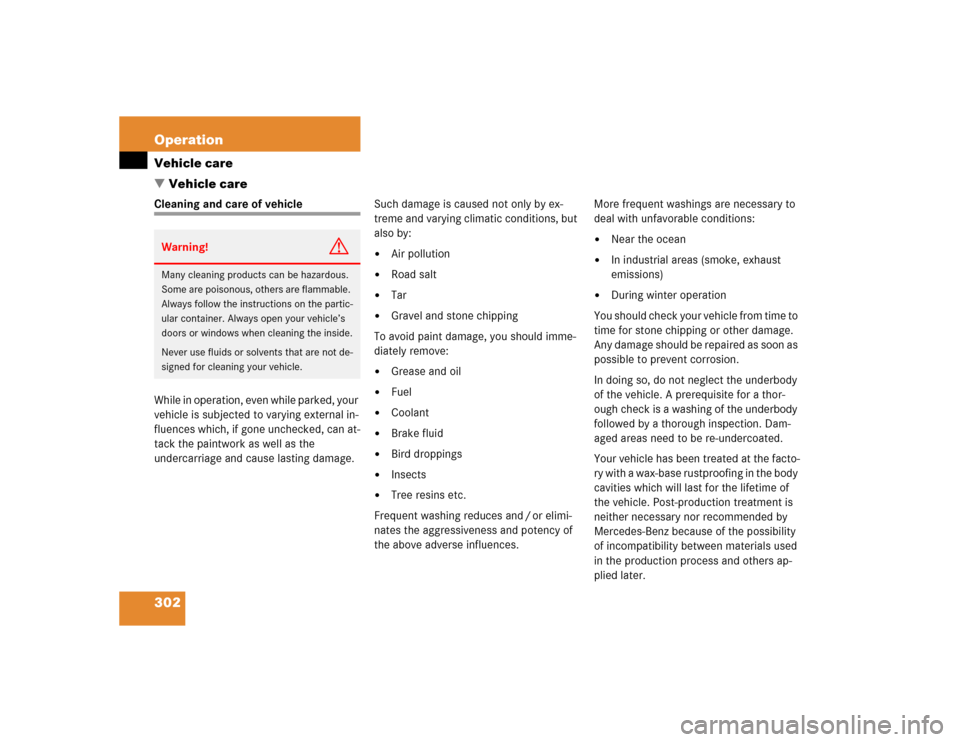
302 OperationVehicle care
�Vehicle careCleaning and care of vehicle
While in operation, even while parked, your
vehicle is subjected to varying external in-
fluences which, if gone unchecked, can at-
tack the paintwork as well as the
undercarriage and cause lasting damage.Such damage is caused not only by ex-
treme and varying climatic conditions, but
also by:
�
Air pollution
�
Road salt
�
Tar
�
Gravel and stone chipping
To avoid paint damage, you should imme-
diately remove:
�
Grease and oil
�
Fuel
�
Coolant
�
Brake fluid
�
Bird droppings
�
Insects
�
Tree resins etc.
Frequent washing reduces and / or elimi-
nates the aggressiveness and potency of
the above adverse influences.More frequent washings are necessary to
deal with unfavorable conditions:
�
Near the ocean
�
In industrial areas (smoke, exhaust
emissions)
�
During winter operation
You should check your vehicle from time to
time for stone chipping or other damage.
A n y d a m a g e s h o u l d b e r e p a i r e d a s s o o n a s
possible to prevent corrosion.
In doing so, do not neglect the underbody
of the vehicle. A prerequisite for a thor-
ough check is a washing of the underbody
followed by a thorough inspection. Dam-
aged areas need to be re-undercoated.
Your vehicle has been treated at the facto-
ry with a wax-base rustproofing in the body
cavities which will last for the lifetime of
the vehicle. Post-production treatment is
neither necessary nor recommended by
Mercedes-Benz because of the possibility
of incompatibility between materials used
in the production process and others ap-
plied later.
Warning!
G
Many cleaning products can be hazardous.
Some are poisonous, others are flammable.
Always follow the instructions on the partic-
ular container. Always open your vehicle’s
doors or windows when cleaning the inside.
Never use fluids or solvents that are not de-
signed for cleaning your vehicle.
Page 313 of 442
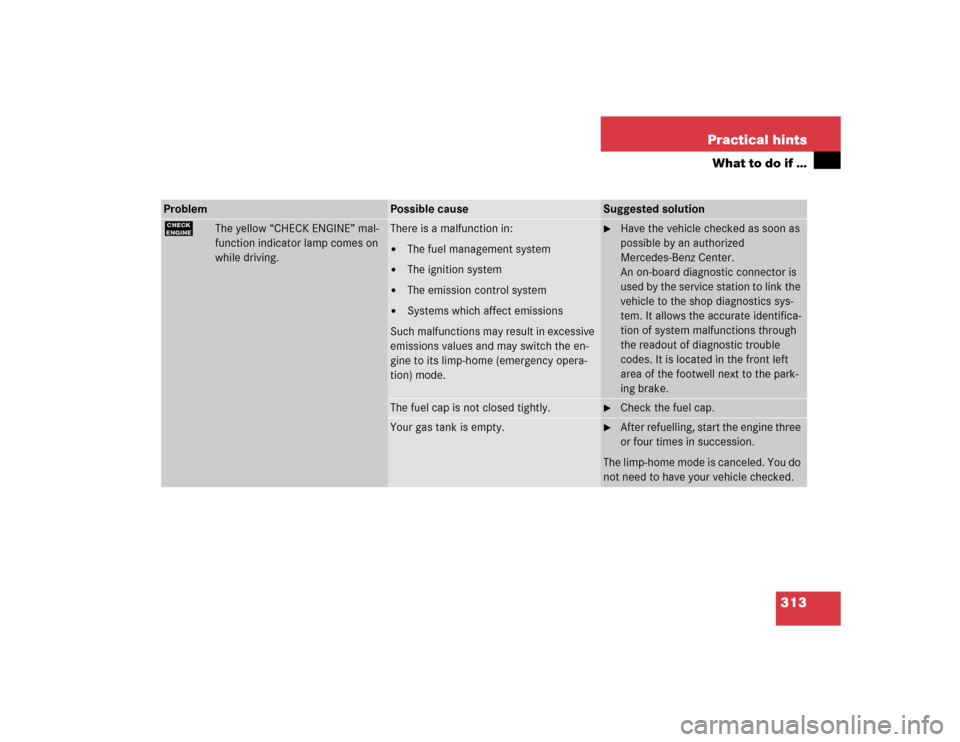
313 Practical hints
What to do if …
Problem
Possible cause
Suggested solution
?
The yellow “CHECK ENGINE” mal-
function indicator lamp comes on
while driving.
There is a malfunction in:�
The fuel management system
�
The ignition system
�
The emission control system
�
Systems which affect emissions
Such malfunctions may result in excessive
emissions values and may switch the en-
gine to its limp-home (emergency opera-
tion) mode.
�
Have the vehicle checked as soon as
possible by an authorized
Mercedes-Benz Center.
An on-board diagnostic connector is
used by the service station to link the
vehicle to the shop diagnostics sys-
tem. It allows the accurate identifica-
tion of system malfunctions through
the readout of diagnostic trouble
codes. It is located in the front left
area of the footwell next to the park-
ing brake.
The fuel cap is not closed tightly.
�
Check the fuel cap.
Your gas tank is empty.
�
After refuelling, start the engine three
or four times in succession.
The limp-home mode is canceled. You do
not need to have your vehicle checked.
Page 315 of 442
315 Practical hints
What to do if …
Problem
Possible cause
Suggested solution
l
The red DTR warning lamp
comes on while driving.
You are too close to the vehicle in front of you
to maintain selected speed.
�
Apply the brakes immediately to in-
crease the following distance.
l
The red DTR warning lamp
comes on while driving and you
hear a warning sound.
�
You are gaining too rapidly on the vehicle
ahead of you.
�
The distance warning system has recog-
nized a stationary obstacle on your prob-
able line of travel.
�
Apply the brakes immediately.
�
Carefully observe the traffic situation.
You may need to brake or maneuver
to avoid hitting an obstacle.
W
The yellow fuel tank reserve
warning lamp comes on while
driving.
The fuel level has gone below the reserve
mark.
�
Refuel at the next gas station
(�page 278).
<
The red seat belt warning lamp
flashes for a brief period after
starting the engine.
The warning lamp reminds you to fasten seat
belts.
�
Fasten your seat belt.
Page 329 of 442
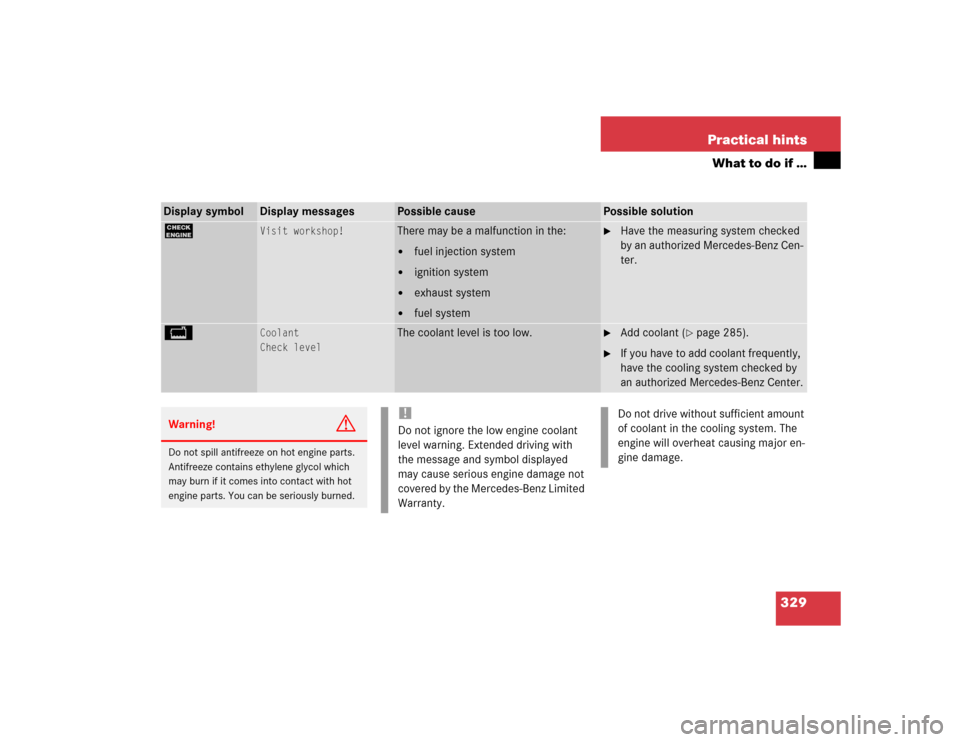
329 Practical hints
What to do if …
Display symbol
Display messages
Possible cause
Possible solution
?
Visit workshop!
There may be a malfunction in the:�
fuel injection system
�
ignition system
�
exhaust system
�
fuel system
�
Have the measuring system checked
by an authorized Mercedes-Benz Cen-
ter.
B
Coolant
Check level
The coolant level is too low.
�
Add coolant (
�page 285).
�
If you have to add coolant frequently,
have the cooling system checked by
an authorized Mercedes-Benz Center.
Warning!
G
Do not spill antifreeze on hot engine parts.
Antifreeze contains ethylene glycol which
may burn if it comes into contact with hot
engine parts. You can be seriously burned.
!Do not ignore the low engine coolant
level warning. Extended driving with
the message and symbol displayed
may cause serious engine damage not
covered by the Mercedes-Benz Limited
Warranty.
Do not drive without sufficient amount
of coolant in the cooling system. The
engine will overheat causing major en-
gine damage.
Page 333 of 442
333 Practical hints
What to do if …
Display symbol
Display messages
Possible cause
Possible solution
:
USA only:Add 1 Qt. engine oil
at next refuelingCanada only:Add 1 Liter engine oil
at next refueling
The engine oil level is too low.
�
Add engine oil (
�page 284) and
check the engine oil level
(
�page 283).
Engine oil level
Stop, engine off!
There is no oil in the engine. There is a
danger of engine damage.
�
Carefully bring the vehicle to a halt as
soon as possible.
�
Turn off the engine.
�
Add engine oil (
�page 284) and
check the engine oil level
(
�page 283).
Engine oil level
Reduce oil level!
You have added too much engine oil.
There is a risk of damaging the engine or
the catalytic converter.
�
Have oil siphoned or drained off. Ob-
serve all legal requirements with re-
spect to its disposal.
Page 335 of 442
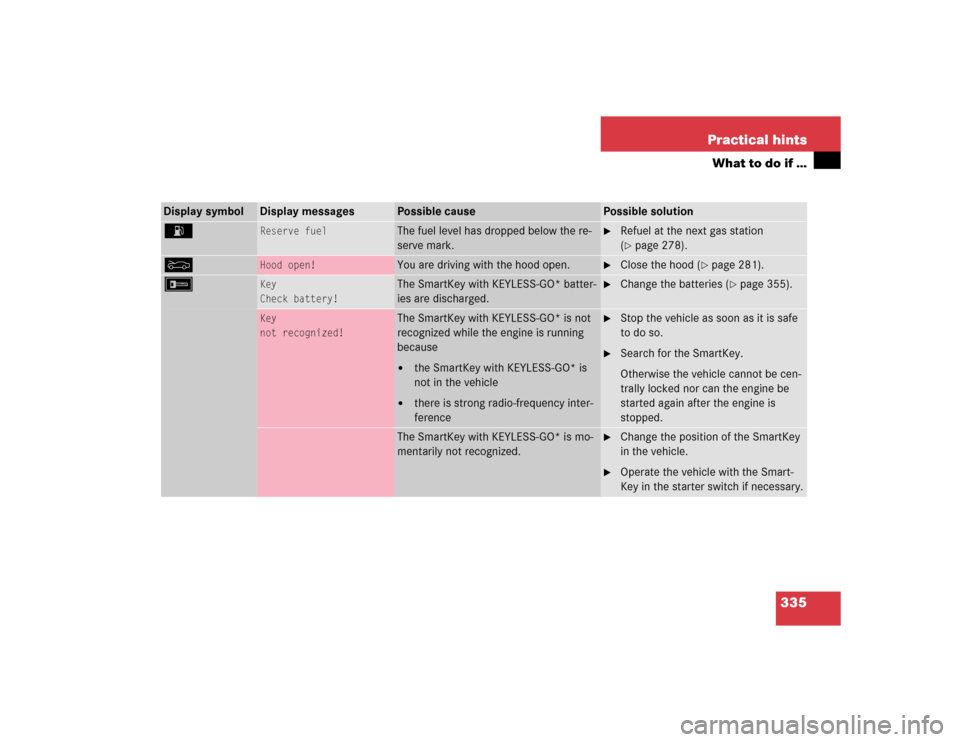
335 Practical hints
What to do if …
Display symbol
Display messages
Possible cause
Possible solution
A
Reserve fuel
The fuel level has dropped below the re-
serve mark.
�
Refuel at the next gas station
(�page 278).
Y
Hood open!
You are driving with the hood open.
�
Close the hood (
�page 281).
F
Key
Check battery!
The SmartKey with KEYLESS-GO* batter-
ies are discharged.
�
Change the batteries (
�page 355).
Key
not recognized!
The SmartKey with KEYLESS-GO* is not
recognized while the engine is running
because�
the SmartKey with KEYLESS-GO* is
not in the vehicle
�
there is strong radio-frequency inter-
ference
�
Stop the vehicle as soon as it is safe
to do so.
�
Search for the SmartKey.
Otherwise the vehicle cannot be cen-
trally locked nor can the engine be
started again after the engine is
stopped.
The SmartKey with KEYLESS-GO* is mo-
mentarily not recognized.
�
Change the position of the SmartKey
in the vehicle.
�
Operate the vehicle with the Smart-
Key in the starter switch if necessary.
Page 357 of 442
357 Practical hints
Unlocking / locking in an emergency
Fuel filler flap emergency release
In case the central locking system does
not release the fuel filler flap, you can open
it manually.
1Release knob�
Open trunk lid.
�
Remove right-side tail trim.
�
Turn release knob1 clockwise (ar-
row).
The fuel filler flap can know be opened.Manually unlocking the transmission
selector lever
In the case of power failure, the transmis-
sion selector lever can be manually un-
locked, e.g. to tow the vehicle.
1Pin
�
Open the storage compartment in the
center console (
�page 244).
�
Take out the cup holder*.
Using two fingers in the horizontal slot
at the upper rear side of the cup holder,
lift cup holder upwards to remove.
�
Hold the cover at a 45° angle.
�
Insert a suitable object1 (e.g. a pin)
through the hole and press the pin
downward.
�
Remove pin1. iThe selector lever is locked again when
moving it to positionP.